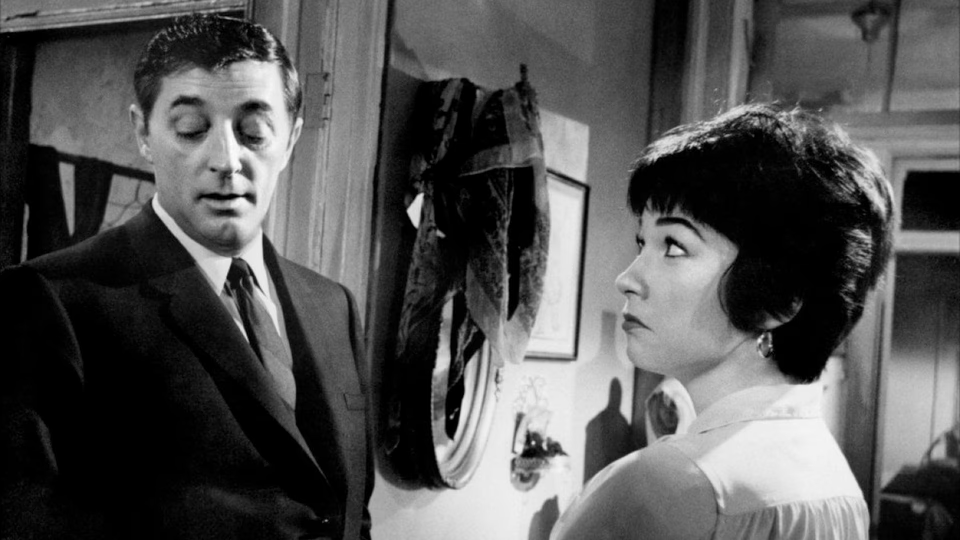Two for the Seesaw

Robert Mitchum has range. He can play stoic heros, scheming villains—even an Australian drover. But he can’t convince as a moping neurotic.
Yet, in Two for the Seesaw, he plays a middle-aged, midwestern lawyer who—after his wife of twelve years asks for a divorce—has a mid-life crisis and flees his cushy job and pampered lifestyle for New York City. There, he meets a late twentysomething dancer played by Shirley MacLaine. A romance blooms, but will their separate worlds mesh?
Director Robert Wise follows up his technicolor musical West Side Story with a more modest endeavor: a two-character, black and white relationship drama. Like West Side Story, it’s set in New York City, but most of the story unfolds in two apartment sets. That’s not to suggest the film looks cheap. The cramped sets feel authentic, from the chipped and peeling paint to the narrow doorways and poor lighting.
The opening scenes following Mitchum on the Brooklyn bridge and wandering the New York streets evoke a terrific atmosphere. They establish the city as ever-present—both bustling and isolating—the alluring enigma that’s attracted generations of transplants. They also serve as an intriguing time capsule—see the big Brookhattan sign.
But these same scenes betray the film’s biggest problem. Seeing Mitchum take a big sigh on the bridge, mope around town, take a big sigh at the Met, mope around town some more—I couldn’t buy it. Like Dean Martin, Mitchum’s cool comes from his innate detachment. The sense that he knows he’ll be fine no matter what happens and thus doesn’t care.
Casting Mitchum in this role is like casting him in Jack Lemmon’s part in The Apartment—or casting Lemmon in Mitchum’s part in Cape Fear.
Lemmon would have shined in this role. So would a younger Henry Fonda. I was surprised to learn the film originated as a stage play with Fonda and Anne Bancroft as the leads. A fifty-seven-year-old Fonda wouldn’t have worked in this film, but a forty-seven-year-old one would have been dynamite.
Unlike Mitchum, MacLaine convinces. She tempers her character’s free spirit energy with hard-earned street-sense, pivoting from unglamorous to alluring, flashing her large eyes and conveying an infectious sense of warmth and generosity. And she has solid chemistry with Mitchum. You may struggle to understand what her character would see in his character, but you can understand what Shirley MacLaine would see in Robert Mitchum. A subtle distinction that keeps the film engaging despite the lack of emotional stakes.
And yet, Mitchum’s miscasting lends the ending an unexpected resonance. Warning, spoilers follow.
While the script attempts to restore the social norms, Mitchum’s innate nature betrays any sense of hope. What’s supposed to seem bittersweet—Mitchum returning to a fresh start with his ex-wife—takes on nihilistic undertones thanks to his detachment. We can’t see it working out with his ex-wife any more than it could with MacLaine’s character. He’s trapped and knows it.
This reframes MacLaine’s character’s ending. Without buying that Mitchum has changed, we can’t believe MacLaine has either. She’s doomed to repeat her cycle of falling for broken men who abuse her selfless generosity.
Quite the fatalistic perspective for a high-profile studio picture. I wonder how contemporary audiences reacted. Modern audiences may chafe at Mitchum’s overt chauvinism, but MacLaine’s reactions show how such behavior was acceptable at the time.
I can’t recommend Two for the Seesaw, but I can’t recommend against it either. It’s a flawed picture but flawed in a way that lends an unexpected depth. Given the two hour running time, I wouldn’t seek it out. But if you’re a Mitchum or MacLaine fan and you’ve exhausted their better efforts, give it a shot.